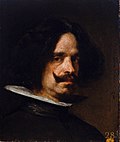Category:Dwarf with a Dog, formerly denominated Antonio el Inglés (Circle of Velázquez - Museo del Prado)
Jump to navigation
Jump to search
| Dwarf with a Dog, formerly denominated Antonio el Inglés (Circle of Velázquez - Museo del Prado) | ||||||||||||||||||||||||||||||||||||||||||||||||||||||||||||||||||||||||||||||||||
|---|---|---|---|---|---|---|---|---|---|---|---|---|---|---|---|---|---|---|---|---|---|---|---|---|---|---|---|---|---|---|---|---|---|---|---|---|---|---|---|---|---|---|---|---|---|---|---|---|---|---|---|---|---|---|---|---|---|---|---|---|---|---|---|---|---|---|---|---|---|---|---|---|---|---|---|---|---|---|---|---|---|---|
| ||||||||||||||||||||||||||||||||||||||||||||||||||||||||||||||||||||||||||||||||||
painting by circle of Velázquez | |||||
| Upload media | |||||
| Instance of | |||||
|---|---|---|---|---|---|
| Depicts | man, dwarfism, dog, standing, brown hair, waist-length hair, moustache, hat, Spanish Mastiff, sword and soul patch | ||||
| Made from material | |||||
| Genre | |||||
| Location | |||||
| Country of origin | |||||
| Creator |
| ||||
| Owned by | |||||
| Collection | |||||
| Inventory number |
| ||||
| Inception |
| ||||
| Width |
| ||||
| Height |
| ||||
| |||||
Media in category "Dwarf with a Dog, formerly denominated Antonio el Inglés (Circle of Velázquez - Museo del Prado)"
The following 8 files are in this category, out of 8 total.
-
Diego Velázquez 019.jpg 1,442 × 1,920; 2.03 MB
-
Diego Velázquez 019FXD.jpg 1,442 × 1,920; 719 KB
-
Velazquez (1907) (14781295952).jpg 2,804 × 3,816; 1.72 MB
-
Portrait of Don Antonio, court dwarf of Philip II. Wellcome M0017134.jpg 2,787 × 3,792; 3.55 MB
-
AJM 1968 MiNr0219A pm B002.jpg 1,348 × 1,691; 832 KB
-
Don Antonio, a dwarf to Philip IV. Etching by B. Maura y Mon Wellcome V0006965.jpg 2,390 × 2,942; 3.01 MB
Categories:
- Male portrait paintings by Diego Velázquez in the Museo del Prado
- Spanish Baroque paintings in the Museo del Prado
- 17th-century portrait paintings in the Museo del Prado
- 17th-century portrait paintings of unidentified men
- 1640s oil on canvas paintings in Spain
- 1640s portrait paintings from Spain (male)
- 17th-century fashion in Spain
- 17th-century oil portraits of standing men at full length
- 17th-century portrait paintings of men by title
- 17th-century portrait paintings of men with brown clothing
- 17th-century portrait paintings of men with presumed sitter
- 17th-century portrait paintings with dogs
- 17th-century three-quarter view portrait paintings of men, facing right and looking at viewer
- Baroque paintings of men
- Court dwarves
- Male boots in portrait paintings
- Paintings of people with dwarfism
- Portrait paintings by Diego Velázquez by title
- Portrait paintings of men holding feathered hats
- Portrait paintings of men with dogs
- Portrait paintings of standing men with left arm down
- Portrait paintings of standing men with right hand holding hats
- Split-sleeve jacket with protruding chemise











